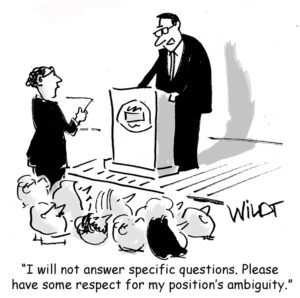Back in the early 70’s, I produced a worship songbook titled, “Gonna Shout For Joy.” It included several pages talking about the work and make up of worship, plus some original songs to be used in worship. One of the elements of worship that was important to me was a tolerance for ambiguity. That is to say, we need to have an open mind about what we don’t yet understand. Each of our spiritual journeys wander through life’s many paths, and we are all at a different place in that journey. Needless to say, we encounter many obstacles that seem to get in the way of our journey. We encounter ambiguity.
The dictionary definition of ambiguity is, “the quality of being open to more than one interpretation.” The question becomes, what is truth? Is there only one singular interpretation of truth or are there a variety of truths subject to a historical, cultural and racial context?
Let’s look at Love as an obvious example. There is a cultural context of love, and also a religious context of love. They do overlap each other.
 Christianity adopted the Greek examples of the five kinds of love:
Christianity adopted the Greek examples of the five kinds of love:
- Storge – empathy bond
- Philia – friend bond
- Eros – romantic love
- Agape – unconditional “God” love
- Compassion (karuna) – the desire to remove suffering from the other person
Buddhism says it this way:
- Loving-kindness (maitri) – the desire to offer happiness
- Compassion (karuna) – the desire to remove suffering from the other person
- Joy (mudita) – the desire to bring joy to people around you
- Equanimity (upeksha) – the desire to accept everything and not to discriminate
Here are the five stages of love as the Hindus see them:
- “ Kama,” or sensory craving
- “Shringara,” or rapturous intimacy (sex without true intimacy and sharing can leave us feeling empty)
- “Maitri,” or generous compassion
- “Bhakti,” or impersonal devotion
- “Atma-Prema,” or unconditional self-love
I have no intention of analyzing each of these definitions of love from the different faith perspectives, but simply say that they are very compatible with each other. Yet, the various kinds of love often get in the way of each other. Romantic love (Eros), for example, can pull us away from Philia and Agape love. Add dimensions of guilt and jealousy, and you have more ambiguity than you can handle!
Amidst such ambiguity, what is truth? As I take on the mantra of old age, I am not sure I believe that there is one singular truth about anything. Truth is always sheltered in context of culture and personal perspective.
Don’t get me wrong here, I do believe that there are universal truths that are unchanging, like God is love, regardless of how you understand the creator source. Another would be, we reap what we sow. Paul understood this (Galatians 6:7). You can’t plant corn and hope it comes up as beans, no matter how hard and diligent you pray. To say it another way, you can’t be rude and bullish and hope it comes off as kindness and compassion.
Many Christians have believed the notion that the Christian faith is the one and only true faith. Every other faith tradition is wrong because they don’t acknowledge Jesus as the only purveyor of religious truth. I believed that for the first seventeen years of my life, this traditional notion of faith was fed and pounded into me. Yet, I could never understand why Catholics, just because they were Catholic, were going to hell, at least according to my tradition. This was also true for Buddhists, Hindu’s and particularly Muslims.
I no longer believe that way. As Paul said in the thirteenth chapter of I Corinthians, “when I was a child, I believed childish truths; I am not longer a child and now need adult truths.” In essence, I believe Paul to be saying, “as a child I believed in Santa and the Easter Bunny, but now that I am an adult, I understand that Santa and the Easter Bunny are metaphors for childish truths that presuppose the notion of giving, gratitude and new understandings about life. My mind needed those simple explanations as a child but now I am an adult and need more complex explanations about the being of God and myself.” Often, those complex explanations bring a healthy amount of ambiguity. It is in the very core of that ambiguity that God can be found and therefore, it becomes a “righteous ambiguity.”
Righteousness in the Bible has always triggered ambiguity for me. What does it literally mean? In Hebrew (same in Aamaic) the word is ‘tzedek’ and is used 500 times in the Old Testament. It means integrity, honesty, equity and rightness. The New Testament expression is ‘dikaios’ and is used 200 times. Its meaning is similar to the Old Testament but expresses justice and a ‘right’ way of acting, and I would add, thinking.
Hence, righteous ambiguity would mean something like, an interpretation that express two or more options allowing the individual to wrestle with which option serves the greater good. More times than not, our choices regarding an ambiguity are more about our own personal and selfish needs.
That being said, the ontological question of being, about God and myself, brings with it ambiguity. I’m okay with that. I am on a soul journey. Each day brings a little more understanding, but also a little more ambiguity. So, it is. Praise God for ambiguity!




